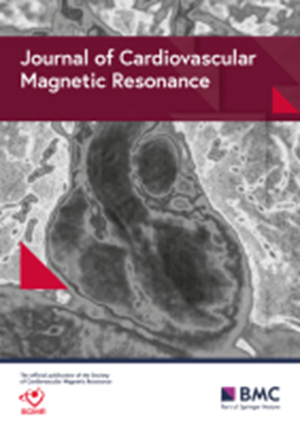结合生成建模和半监督领域适应,实现全心脏心血管磁共振血管造影分割
IF 4.2
1区 医学
Q1 CARDIAC & CARDIOVASCULAR SYSTEMS
引用次数: 0
摘要
量化三维(3D)心脏解剖结构对于评估心血管疾病非常重要。解剖结构的变化表明心脏组织适应疾病的重塑过程。虽然计算机断层扫描血管造影(CTA)存在稳健的分割方法,但全心心血管磁共振血管造影(CMRA)却鲜有方法,因为对比度不一、信噪比较低、标注数据量有限,所以CMRA更具挑战性。我们将两种最先进的无监督生成式深度学习领域适应架构--生成对抗网络和变异自动编码器,应用于传统(n = 20)和高分辨率(n = 45)CMRA(目标)图像的三维全心分割,并将分割后的 CTA(源)图像作为训练对象。在 10%、20% 和 30% 的 CMRA 分割情况下,采用了额外的监督损失函数来提高性能。在给定的 CMRA 分割上训练的完全监督 nn-UNet 被用作基准。在标准数据集和高分辨率数据集中,增加少量分段 CMRA 训练案例大大提高了生成式架构的性能。与 nn-UNet 基准相比,生成式方法在标注案例有限的情况下表现得更好。在标准 CMRA 数据集上,Dice 分数平均提高了 12%(对抗方法)和 10%(变异方法)。通过增加少量有监督的目标训练案例,可以提高用于 CMRA 分割的无监督领域适应方法的性能。在只有少量标记案例的情况下,半监督生成模型优于监督方法。本文章由计算机程序翻译,如有差异,请以英文原文为准。
Combining generative modelling and semi-supervised domain adaptation for whole heart cardiovascular magnetic resonance angiography segmentation
Quantification of three-dimensional (3D) cardiac anatomy is important for the evaluation of cardiovascular diseases. Changes in anatomy are indicative of remodeling processes as the heart tissue adapts to disease. Although robust segmentation methods exist for computed tomography angiography (CTA), few methods exist for whole-heart cardiovascular magnetic resonance angiograms (CMRA) which are more challenging due to variable contrast, lower signal to noise ratio and a limited amount of labeled data. Two state-of-the-art unsupervised generative deep learning domain adaptation architectures, generative adversarial networks and variational auto-encoders, were applied to 3D whole heart segmentation of both conventional (n = 20) and high-resolution (n = 45) CMRA (target) images, given segmented CTA (source) images for training. An additional supervised loss function was implemented to improve performance given 10%, 20% and 30% segmented CMRA cases. A fully supervised nn-UNet trained on the given CMRA segmentations was used as the benchmark. The addition of a small number of segmented CMRA training cases substantially improved performance in both generative architectures in both standard and high-resolution datasets. Compared with the nn-UNet benchmark, the generative methods showed substantially better performance in the case of limited labelled cases. On the standard CMRA dataset, an average 12% (adversarial method) and 10% (variational method) improvement in Dice score was obtained. Unsupervised domain-adaptation methods for CMRA segmentation can be boosted by the addition of a small number of supervised target training cases. When only few labelled cases are available, semi-supervised generative modelling is superior to supervised methods.
求助全文
通过发布文献求助,成功后即可免费获取论文全文。
去求助
来源期刊
CiteScore
10.90
自引率
12.50%
发文量
61
审稿时长
6-12 weeks
期刊介绍:
Journal of Cardiovascular Magnetic Resonance (JCMR) publishes high-quality articles on all aspects of basic, translational and clinical research on the design, development, manufacture, and evaluation of cardiovascular magnetic resonance (CMR) methods applied to the cardiovascular system. Topical areas include, but are not limited to:
New applications of magnetic resonance to improve the diagnostic strategies, risk stratification, characterization and management of diseases affecting the cardiovascular system.
New methods to enhance or accelerate image acquisition and data analysis.
Results of multicenter, or larger single-center studies that provide insight into the utility of CMR.
Basic biological perceptions derived by CMR methods.

 求助内容:
求助内容: 应助结果提醒方式:
应助结果提醒方式:


